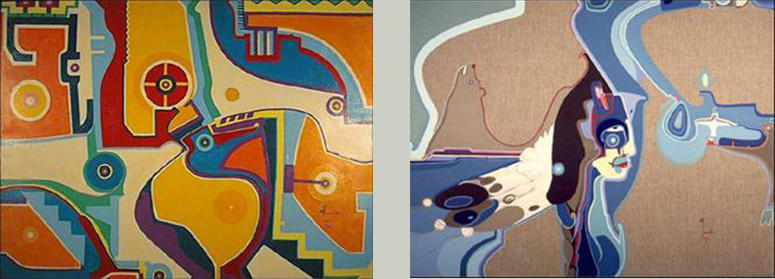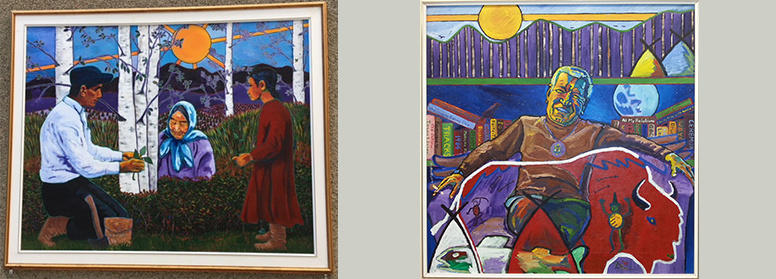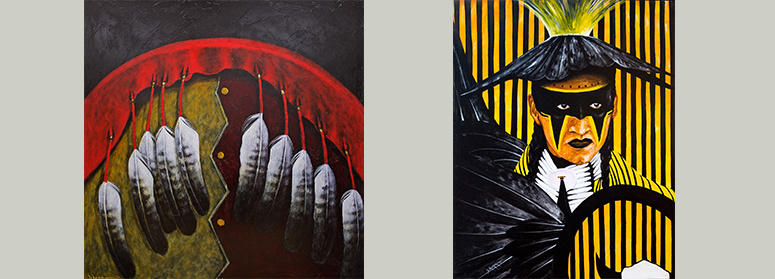April 4, 2018
Your guide to navigating Indigenous art on campus

Impressive artworks by Indigenous artists can be found on the University of Calgary campus.
Since the launch of ii' taa' poh' to' p, the University of Calgary’s Indigenous Strategy, in November 2017, the university has been buzzing with new visions for a decolonized campus. Part of this process will have to do with new approaches to space and place, including artwork, buildings and interior design. The strategy outlines a goal to “…create a sense of belonging, increasing the visibility of Indigenous people and their cultures throughout campus, and expanding recognition and the traditional acknowledgement of territory in which the university campus is situated.”
While there is still much work to be done, there are currently a number of impressive artworks by Indigenous artists — including several alumni and internationally renowned artists — tucked away on campus.

City Dwelling (1972) and Northern News Bearer (1977) by Alex Janvier (b. 1935). Acrylic paintings.
Nickle Galleries
Alex Janvier
Two exceptional pieces in the Nickle Galleries’ collection of art, City Dwelling and Northern News Bearer, showcase Alex Janvier’s signature style that combines lyrical abstraction with representational images, often in bright, symbolic colours.
Of northern Albertan Denesuline and Saulteaux descent, and a residential school survivor, Janvier addresses his past in his painting — his work deals with the history of oppression and struggle for cultural empowerment, but it is also celebratory. Janvier is known as a member of the “Indian Group of Seven,” the pioneering group of Indigenous artists including Norval Morriseau and Daphne Odjig. He graduated from the Alberta College of Art and Design in 1960, and later taught at the University of Alberta. In 2008 he received Honourary Doctor of Laws degrees from both the University of Calgary and the University of Alberta.
Janvier’s work is part of more than 25 public and private art collections. He is a member of the Order of Canada, a member of the Alberta Order of Excellence, Queen Elizabeth II Diamond Jubilee award recipient, recipient of the National Aboriginal Lifetime Achievement Award, and the 2017 Lieutenant Governor of Alberta Distinguished Artist Award. The National Gallery of Canada has organized a major touring retrospective of his work, Alex Janvier: Modern Indigenous Master, that will be at Calgary’s Glenbow Museum June 16 through Sept. 9, 2018. He currently runs an art gallery called Janvier Gallery in Cold Lake, Alta. with his family.

White Bear (1992) and Wolf Child (2011) by Jane Ash Poitras (b. 1951). Oil paintings.
Nickle Galleries, left, and by Riley Brandt, University of Calgary, right
Jane Ash Poitras
White Bear is part of the Nickle Galleries’ extensive collection of more than 3,500 artworks. A Cree artist born on the Mikisew Cree First Nation in Fort Chipewyan, Alta., and raised in Edmonton, Jane Ash Poitras actually began her career as a microbiologist. At age 30, her focus turned to art and she received a BFA in printmaking from the University of Alberta, and an MA in painting and sculpture from Columbia University in New York City.
Poitras’s paintings and prints are known for their rich and vibrant colour, as well as for the many layers that incorporate images, passages of text, and collaged elements. Her work is emotionally charged, seeking to combine and reconcile disparate aspects of Indigenous, western and world culture, spirituality and history.
White Bear (1992), above, left, is located in the Executive Suite of the Administration Building, while Wolf Child (2011), right, is located in the Native Centre.
In 2009, she received the Lieutenant Governor of Alberta Distinguished Artist Award, and became an Order of Canada recipient in 2017. In 2015, Poitras received Honourary Doctor of Laws (LLD) degrees from the University of Calgary and the University of Alberta. In 2011, the University of Calgary Press published Cultural Memories and Imagined Futures: The Art of Jane Ash Poitras by Pamela McCallum — a richly illustrated study of her art and career.

The Ancestors are Watching (1992) and Stan Gibson (1995) by Frederick McDonald (b. 1957).
Pauline Zulueta, left, and courtesy of the Native Centre, right
Frederick McDonald
Frederick McDonald is Woodland Cree, born in Fort McMurray and raised following a traditional Indigenous lifestyle along the Athabasca River. He attended the University of Calgary and received a BFA in 1995 and a MFA in 2002.
His works illustrate a deep connection to the land and the importance of tradition and spirituality in Indigenous culture. Commissioned by the Cumming School of Medicine to commemorate its 25th anniversary, The Ancestors are Watching depicts the healing power of medicines that come from Mother Earth and the teaching of traditional ways from generation to generation.
The Ancestors are Watching (1992), above, left, is located in the Libin Theatre on Foothills Campus, while Stan Gibson (1995) is located in the Native Centre.
McDonald’s works are held in public collections in Canada, the United States, Europe and Japan, and he has received numerous awards including the Regional Aboriginal Recognition Award in 1995, and was included in the Alberta Biennial of Contemporary Art in 1998. He currently lives and works on the Fort McKay First Nation, using art to help preserve the nation’s identity and to inspire young artists. You can learn more about McDonald in the book Ancestral Portraits, which was published by the University of Calgary Press in 2002.

Red Tail Feathers Shield (2003) and The Rain Man (1994) by Dale Auger (1958 – 2008). Oil paintings.
Native Centre, left, and by Riley Brandt, University of Calgary, right
Dale Auger
A Sakaw Cree from the Bigstone Cree Nation in northern Alberta, Dale Auger was a prolific visual artist, storyteller, playwright and comedian. His vividly coloured acrylics have captured the complexities of Indigenous history, as well as the intricate links between Indigenous spirituality and the natural laws of the land.
Auger studied at Grant MacEwan College, Mount Royal College, Alberta College of Art and Design, and the University of Calgary, where he completed his Bachelor of Education (1992), Master of Education (1996), and PhD in Education (1999).
His acrylic and oil paintings are held in many notable public and private collections around the world. He is also the author of an award-winning children's book, Mwakwa Talks to the Loon, for which he was awarded Aboriginal Children's Book of the Year in 2006, and received the 2007 R. Ross Annett Award for Children's Literature.
Red Tail Feathers Shield (2003), above, left, is located in the Native Centre, while The Rain Man (1994), right, is located in the Faculty of Law in Murray Fraser Hall.
---
Thank you to Cheryle Chagnon-Greyeyes, administrative co-ordinator at the Native Centre and to Christine Sowiak, curator of the Nickle Galleries for offering their wealth of resources and knowledge about Indigenous art on campus.
ii’ taa’poh’to’p, the University of Calgary’s Indigenous Strategy, is a commitment to deep evolutionary transformation by reimagining ways of knowing, doing, connecting and being. Walking parallel paths together, ‘in a good way,’ UCalgary will move towards genuine reconciliation and Indigenization.
